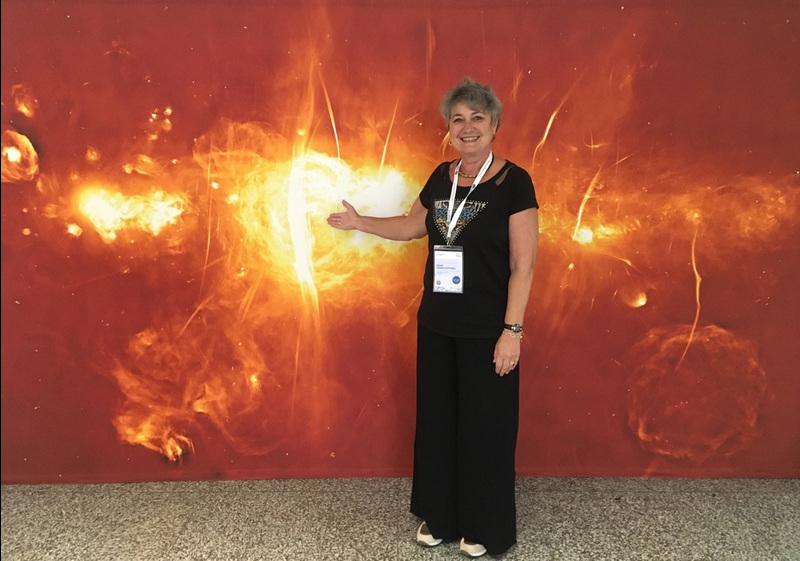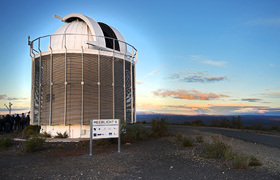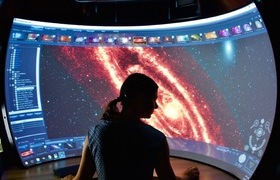MeerKAT Award for UCT Chair of Astronomy
30 August 2018 | Story Di Caelers. Photo Supplied. Read time 5 min.
Chair of Astronomy Professor Renee Kraan-Korteweg flew the flag with distinction for the University of Cape Town (UCT) when she won the Minister’s Special Award in the field of astronomy at the South African Women in Science Awards (SAWISA) 2018.
Kraan-Korteweg was among a host of top women achievers in science, technology and innovation fêted by the national Department of Science and Technology at a glittering awards ceremony in Limpopo on 23 August.
The Minister’s Special Award in the field of astronomy, the Commemorative MeerKAT Award, went to the UCT professor in recognition of her “outstanding contribution to building South Africa’s scientific and research knowledge base in advancing the field of astronomy”.
She was recognised for distinguishing herself “in the field of South African radio astronomy by advancing the science of radio astronomy through her scientific contributions”.
Further, she was lauded for her success in respect of training the next generation of radio astronomers, and for helping to elevate radio astronomy as a strategic research field. This was achieved via contributions “beyond scientific output and the training of postgraduate students”.
Kraan-Korteweg pioneered radio astronomy in the Western Cape when she took up the chair to head UCT’s astronomy department in 2005. In 2006 she was behind the launch of an astronomy major, and she says she immediately offered the first radio astronomy research projects to young South African postgraduate students. She also brought the first radio astronomy Research Chairs to South Africa.
“The awards are not only prestigious, but also inspiring.”
Prestigious and inspiring
The theme for this year’s event, “100 Years of Mama Albertina Sisulu: Women United in Moving South Africa Forward”, honoured Sisulu’s great courage as a unifying leader during the apartheid era. In 1956 Sisulu was instrumental in leading about 200 000 women in a march on the Union Buildings in Pretoria to protest the pass laws.
Minister of Science and Technology Seipati Makunyane said in her keynote address that the awards were not only prestigious but also inspiring.
“This occasion challenges us to reflect on the current situation in the world of science, research and technology in our country, and the strides made in bridging the gaps that exist,” she said.
The Department of Science and Technology recently launched the 64-antennae MeerKAT in what was hailed as a milestone of science and astronomy in South Africa. The award to Kraan-Korteweg was a commemorative one to celebrate the MeerKAT, given to “an outstanding woman astronomer”.
Groundbreaking discovery
Kraan-Korteweg, who is also the chair of the South African Astronomy Advisory Council and vice-president of the International Astronomical Union, made international news in 2016 when she was one of only two South Africans on an international team of astronomers who managed to explore behind thick clouds of dust particles in the Milky Way. These had previously made it impossible to map large parts of the sky.
That team announced a groundbreaking discovery of 883 new galaxies following nearly two decades of painstaking research.
Later the same year Kraan-Korteweg led the team that announced their discovery of another massive supercluster of galaxies, also previously obscured behind dust and stars around the plane of the Milky Way.
The concentration of galaxies, which they dubbed the Vela supercluster, is located in the constellation Vela – in the largely unknown area rather aptly called the Zone of Avoidance (ZOA), for the challenge it poses in viewing distant objects.
Mapping the sky
At the time Kraan-Korteweg likened astronomers to “explorers of the universe”, saying that work was like “in the past, when they started making maps of the Earth”.
“We are making maps of the sky,” she was quoted as saying.
“We are making maps of the sky.”
She is also an active participant in various MeerKAT HI Large Survey Projects and, in preparation, is pursuing precursor projects that involve testing galaxy extraction pipelines based on a large ZOA WSRT (Westerbork Synthesis Radio Telescope) mosaic. This is a proposed MeerKAT early science project.
This will function as a pilot project for assessing the reliability of galaxy extraction and parameterisation tools that the MeerKAT Laduma and Fornax HI Large Survey Projects will apply.
UCT’s astronomy department is the only dedicated, independent university department focused on astronomy in South Africa, with strong ties and joint positions with the South African Astronomical Observatory and significant interaction with the Square Kilometre Array (SKA) SA project office. Until the SKA is completed, the 10-year MeerKAT project offers one of the largest radio telescopes in the world for research.
 This work is licensed under a Creative Commons Attribution-NoDerivatives 4.0 International License.
This work is licensed under a Creative Commons Attribution-NoDerivatives 4.0 International License.
Please view the republishing articles page for more information.










